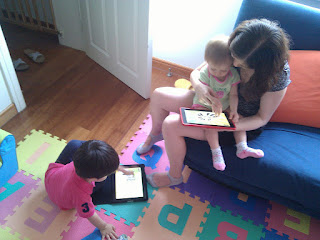Mobile Technologies Provide Continuity Across Various Learning Experiences About Education
General Words:
Several researchers have
suggested that we are entering a new era of technology enhanced learning,
characterized as mobile learning (e.g., Sharples et al., 2005; Tatar et al., 2003),
seamless learning.
Description:
Central to these notions is the
idea that mobile technologies can be designed to enable children to move in and
out of overlapping physical, digital, and communicative spaces. This mobility
can be achieved individually, in pairs, in small groups, or as a whole
classroom together with teachers, mentors, experts, parents, professionals, and
others (Chan et al., 2006).For example, a child might use his iPhone to chat
with a mentor in Second Life about biodiversity while sitting on a bus and
then, based on the expert’s suggestions, join in a snail hunt in his local
park, take photos with his phone, tag the snails’ location using GPS
coordinates, and then send the data, with a suggestion as to what the snails
are, to an online Website on biodiversity.
The biologists monitoring the
site could then send a message back to him verifying whether his identification
of the snails was correct and could then add his data to a national database
that the child could subsequently show to his biology teacher at school. As shown in the previous example, being able
to communicate with others what one is thinking and seeing is an integral part
of learning. Through explaining to others and representing information via
various media, children can be made aware of their own discrepancies in
understanding, enabling them to revise their understanding (c.f. Chi, 1997).
“One way in which learners may
gain from working closely on a problem is by being required to make their
thinking public and explicit” (Crook, 1994, p. 133). Collaboration can increase
awareness, which in turn can enable children to reflect on what they are
currently engaged in. Another concern is whether the focus should be on the
technology being mobile or the extent to which the learner is mobile (Traxler,
2005). In some contexts, it is important that the activities are highly
physical; in others, the portability of the mobile technology is more critical.
For still others, it is the way the device is used among a group of children
during a task that is important. If children are each given a mobile device,
this can promote working by themselves, whereas if they have to share one, they
are required to collaborate more.
Several researchers have sought
to explain the principles behind mobile learning (e.g., Sharples, 2005). Some
have proposed existing learning theories, such as constructivism; others have
suggested that new theories are needed. Most studies to date that investigate
mobile learning have been based on or informed by constructivist theories of
learning, drawing from Vygotsky (1978) and Papert (1980). These propose that we
construct knowledge and meaning from our experiences and that this is best
achieved through doing or making things. Another approach has been to cast the
theoretical underpinning of mobile learning more broadly in terms of embodiment
(e.g., Marshall and Rogers, 2009; Price et al., 2009). Embodiment refers to the
interactions and conversations that happen in our physical and social worlds
and provide meaning (Dourish, 2001).
Conclusion:
A focus is on the intricate
relationship between perception and action and the way that bodily experiences
inform our understanding of abstract concepts. For example, abstract concepts,
such as above, below, up, and down are understood through being physically
experienced in the world (Lakoff and Johnson, 1980). Given that mobile learning
typically involves acting and communicating in a physical and social world,
rather than constructing things per se, it follows that ideas arising from
embodiment may provide a more extensive account.
You Alos Like: Mobile Applications And Tools Have Been Developed To Augment Learning For Kids Education












No comments:
Post a Comment